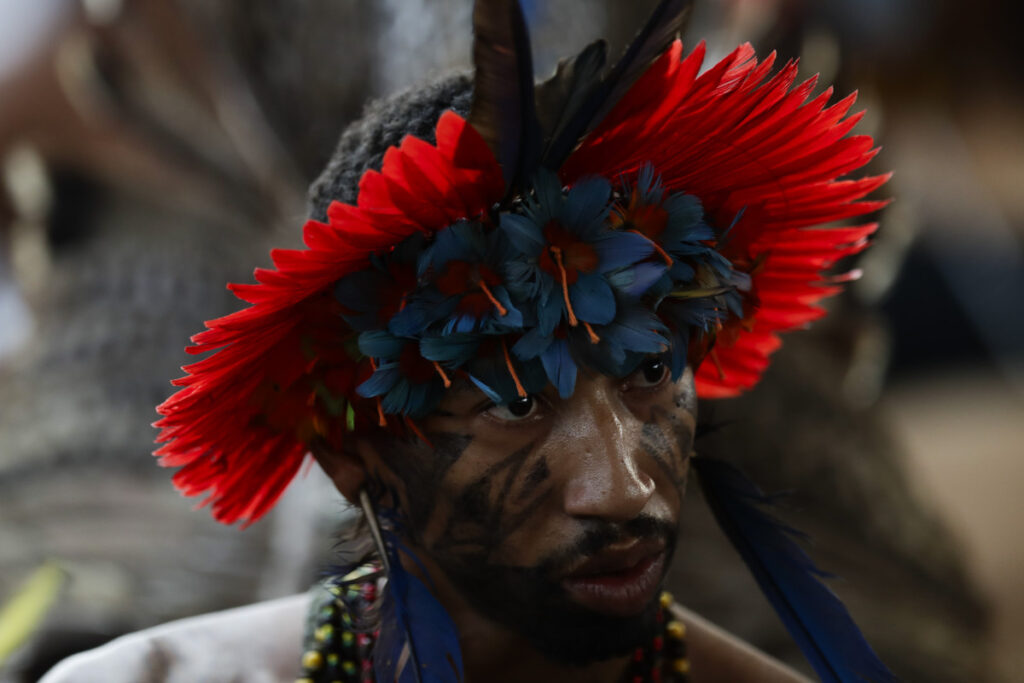RIO DE JANEIRO — Indigenous chants and the rattle of maracas filled a Rio de Janeiro park Thursday as Brazil’s Tupinambá people gathered to celebrate the return of a sacred cloak that disappeared some 380 years ago.
The artifact, made from scarlet ibis feathers, came from northeastern Brazil and was located in Copenhagen until the Danish National Museum donated the cloak to its Brazilian counterpart.
President Luiz Inacio Lula da Silva and Indigenous Peoples Minister Sonia Guajajara attended a ceremony at Brazil’s National Museum on a hill in Boa Vista Park.
“It is impossible not to appreciate the beauty and power of this ancient and well-preserved piece, even after so much time outside Brazil, abroad. It is our commitment to preserve this heritage,” Lula said, addressing dozens of indigenous people and other members of the general public.
Festivities to welcome the cloak have been underway since last week. The Tupinambá traveled 28 hours overland from the northeastern state of Bahia to enter the museum, where the cloak hangs in carefully calibrated light and temperature conditions to ensure its preservation. There, they performed rituals and prayers with the cloak, which they saw as a living ancestor rather than an object.
The reunion with the cloak, once central to certain ceremonies, was “really great,” Jamopoty Tupinambá, one of the group’s leaders, said Wednesday at their camp in the park. “The emotion was too much. The enchanted ones arrived too,” she said, referring to spiritual ancestors.
Some in the camp were beating drums on the dry grass amid the fumes of incense, adorned with feathered headdresses. Anticipation and excitement at the momentous event were in the air.
The cloak is nearly four feet high and was brought to the Netherlands from Brazil around 1644, according to a statement from Brazil’s federal government. It has been in the Danish National Museum for 335 years, the museum said.
“During the colonization process, it (the mantle) was taken away abruptly and violently, taking away from the people what represented their greatest strength,” said Yakuy Tupinambá, an elder of the indigenous group.
Centuries later, in 2000, the Copenhagen museum lent the cloak to an exhibition in Sao Paulo. That was when Jamopoty’s mother, Amotara Tupinambá, saw it for the first time.
“When she got there, she felt great emotion. The cloak showed her: ‘I am here.’ … She was amazed,” Jamopoty recalled. The idea to request the cloak’s permanent return was born.
Years later, Glicéria Tupinamba, from a village in the state of Bahia, traveled to Copenhagen to help identify pieces in their collection. The idea of securing their homecoming grew.
Museums across Europe are under pressure to repatriate cultural objects. For years the Greeks have demanded the return of the sculptures from the Parthenon temple on the Acropolis, which is currently in the British Museum. French President Emmanuel Macron oversaw the much-vaunted return of colonial treasures to Benin in 2021Since then, France has shipped little else of significance, while critics have argued that such moves would empty France’s beloved museums.
The Danish National Museum has received three requests for repatriation in the past decade, chief research officer Christian Sune Pedersen told The Associated Press. They responded positively to two requests, including one from Brazil, and decided to donate one of the five feathered cloaks, partly to help rebuild Brazil’s national museum, which was destroyed by flames. in a devastating fire in 2018.
Its return to Brazil was a complicated operation coordinated by the Ministry of Foreign Affairs, the Brazilian Embassy in Denmark, the national museums of both countries and the Tupinambá leadership.
Extreme care was required not to damage the delicate feathers and the sealed box was opened only once in an air-conditioned room, said João Pacheco de Oliveira, anthropologist and curator of the National Museum’s ethnographic collections.
It is the first time that an indigenous artifact of such importance has been returned to Brazil, he said.
“The expectation is that this will create new opportunities for donations or even repatriation,” he said.
Lula’s government took office in 2023 promising to defend indigenous land rights and created a ministry for indigenous peoples. Such actions stood in contrast to his predecessor, Jair Bolsonaro, who refused to expand indigenous lands.
However, Many indigenous people have complained about the slow pace of Lula’s government to drive out illegal miners and land grabbers from their territories and establish new ones.
Expressing their frustration, Indigenous Peoples Minister Guajajara said Thursday she would like to see more demarcated areas established.
“We really need this number to reflect the desire of the different indigenous peoples, who – like the Tupinambá cloak, our relative, whose return we celebrate today – want to return home,” she told the crowd.
The Tupinambá are among those asking to have their land recognized as an indigenous reserve and given formal protection, a process known as demarcation. Brazil’s Justice Ministry is reviewing their request, according to a June statement from Brazil’s indigenous affairs agency, known as FUNAI.
The return of the cloak is even more meaningful in that context, says Jamopoty Tupinambá.
“The mantle for us is the strength of the people. When he left, the people were weakened. Now he brings strength for the demarcation of his territory.”









